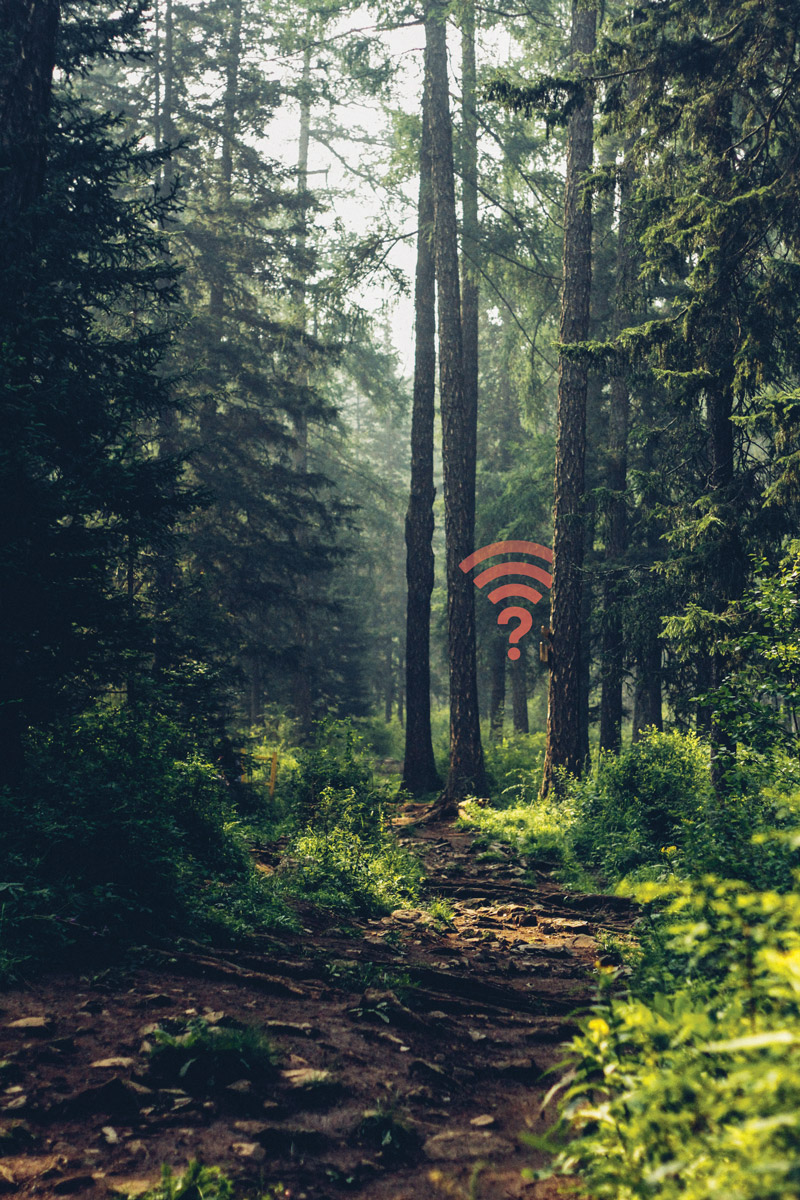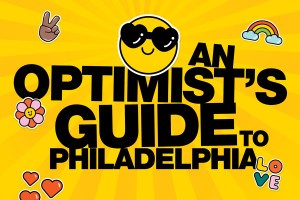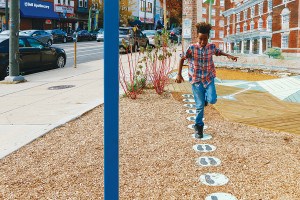Why I Left My City Life to Try Remote Work in the Wilds of Pennsylvania
Millions of Americans — including me — are reconsidering not only how they live, but where. So I tried a three-week program aimed at exposing city workers to rural life.

I packed up for the PA Wilds for a three-week program aimed at exposing city dwellers doing remote work to rural life. / Illustration by Jamie Leary; photograph by Degleex/Unsplash
It’s only late September, but it’s the kind of night that belongs more to early winter than to fall. I wasn’t prepared for it, and I’m shivering. The aluminum bleachers aren’t helping. Floodlights tower overhead, illuminating the football field below and the dark sky above, throwing light on those purple clouds you only see when night has just arrived on a stormy day.
I’m sitting next to two new friends who are also feeling the bite of the premature winter air. One of us doesn’t seem to mind; he’s much more captivated by the football game playing out below us than I am. I take in the players and cheerleaders and homecoming queens and, in a slightly wider orbit, the fans, dressed in royal blue, faithfully rooting for the home team. Beyond them, I can see their scattered kids in a wider orbit still, some playing tag, some probably up to no good. It’s all a familiar scene.
The homecoming game is a core memory from my teenage years. I always figured I’d end up at a high-school field again; I just didn’t expect to find myself there with two 20-something strangers who’ve only just become friends, in a town I don’t live in, in a remote part of Pennsylvania next to millions of acres of wilderness.
Later, when the clock ticks down and the cold becomes too much, we head to the local bar to warm up. Half the town is there, not to celebrate the game — they lost, 26-6 — but to celebrate their home.
For the uninitiated outsider, it would have been odd to find us three 20-somethings, each of us city dwellers, childless, and in no way involved in high-school sports, at the local bar in this tiny town. Innumerable factors conspired to land us in such an unlikely scenario: the sustained population decline in rural America, the pandemic that triggered a massive shift to remote work, and a Pennsylvania program aiming to solve the former by capitalizing on the latter. Without all of it, we would never have found ourselves there that Friday night, shivering on metal bleachers outside a small-town high school on the edge of a humongous forest.
The program that brought us here is the Wilds Are Working, a brand-new initiative with a simple premise: Invite remote workers to spend an expenses-paid month living and working in rural communities, and maybe, just maybe, they might like it and stick around. It takes advantage of the movement toward remote work prompted by the pandemic, and it’s just one of many incentive programs across the country trying to attract some of the more than 20 million Americans who worked remotely in 2021. Bemidji, a midsize town in the northern lakes region of Minnesota, has an entire package of incentives to tempt internet-based workers to its well-connected shores. West Virginia aims to draw people back within its bucolic borders with a $10,000 check to cover moving expenses. Pennsylvania, it turns out, plans to lure those with flexible jobs to its wooded interior with a chance to try it out first, cost-free and risk-free. Hopefully, the thinking goes, some of those trials will result in permanent moves. At the very least, they could refute long-held notions about what it’s really like to live in the middle of nowhere. Regardless, they’ll highlight to the workers and their expansive networks of friends, family and co-workers the charms and virtues of small-town living. It’s all tailor-made for our new digital age, in which location doesn’t seem to matter and any speculative scheme feels worth a try.
A year ago, when the HR department told me that the New York-based role for which I’d just been hired could be, if I wanted, fully remote, my mind short-circuited. I didn’t realize how much I had internalized the lack of control we all have in jobs that tether us to geography. “Yes” was an obvious answer, but giving it left me spinning. At 26, with nothing but a cat and some student debt holding me back, all the promises I heard growing up — that I could do anything, go anywhere — were the closest they would ever be to true. I was fresh out of a relationship and had a shiny new job that required nothing but an internet connection. I was limitless.
I looked up long-term Airbnbs in South America and took stock of the locations of all my scattered friends. I started watching more “van life” videos on TikTok. A question plagued me for months: With each day I stayed in place in Philly — a city I’ve loved since the moment I arrived four years ago — was I squandering this extraordinary freedom? When home could be anywhere, shouldn’t I at least go exploring?
Then, last May, a friend sent me a short write-up in the Inquirer about a new program paying to send remote workers to small towns in Pennsylvania. One session was about to start in an idyllic Victorian town near State College, and another was accepting applications for a small community off Route 6 in the Allegheny National Forest. Participants got free housing and a stipend and could bring pets or family. I could try something new, test my boundaries, taste an alternate version of my future. I replied to my friend with an effusive thank-you and said I would definitely apply. The friend, a skeptic, asked, “Don’t you think you’d get lonely in the middle of nowhere?”
“I can do anything for a month,” I responded. So a few months and an embarrassing application video later, I packed my newly purchased 2002 Honda Accord with my one-year-old cat, Louise; my hiking boots; and three weeks’ worth of clothes. Louise and I then set out on a journey to the middle of nowhere: the one-stoplight town of Kane, Pennsylvania, population 3,500.
Our drive took us through the Pennsylvania Wilds, a rural region that encompasses a quarter of the Commonwealth’s land area but just four percent of its population. The Wilds Are Working program and the Wilds region itself are both overseen by the PA Wilds Center for Entrepreneurship, a nonprofit formed in 2013 to coordinate the conservation and economic efforts of state and local agencies. After mass deforestation in the 19th century, the ecosystem here had been painstakingly restored over the course of 100 years, and protecting it would take a lot of work. So the PA Wilds became the name for the zone that stretches east to west from Lycoming County to Clarion County and north to south from the New York border to I-80. This 2.1-million-acre stretch of public land is, according to the center, “the biggest block of green between New York City and Chicago.”
After nearly six hours, my travel companion and I laid eyes on the sign announcing our arrival to our host town: the borough of Kane, a.k.a. “a star in the forest.” Our accommodations were a neat one-bedroom apartment above a natural grocer, one of many storefront businesses and restaurants in the town’s two-and-a-half-block downtown stretch.
That night, I met some of the other remote workers who would become my friends during the coming weeks. Stephanie, who brought along her boyfriend, Josh, worked as an analyst for a study-abroad program. We learned we lived just blocks from each other back in Philly. I also met Ben, a West Philly-based therapist, and Parul and her husband Robert, residents of Northern Virginia who had family connections in the Wilds.
There was lifelong Kane resident Brandy Schimp, who as mayor earns a princely annual salary of $1,800. There was Joe Lanich, a leftist who runs a printing press with his wife, Andrea, and is close friends with a state police officer — Brandy’s husband. Their sons, both named Henry, are in Cub Scouts together. Such a friendship took me aback; on night one, I was reminded that the country plays by different rules.
I’m not a total newbie about rural living. I grew up passing through a town like Kane on the way from my family’s home in the Chicago suburbs to my grandparents’ house in Indiana, beside a lake smack in the middle of soy and mint fields. Arriving after nightfall, I would step out of our minivan and breathe in the scent of lake water, wet grass, and a lingering note of gasoline. I’d glance up and take in the detail of the cosmos — a sight so singular to those trips that it began to feel like Indiana, my home away from home, fell under a different sky.
The other remote workers and I arrived in Kane during a days-long streak of cloud cover. On those first few evenings, residents assured us we would never see anything like the stars over the Wilds. The skies eventually cleared, but on the many evening walks I took over the course of my time in Kane, I kept forgetting to look up.
Over the next few weeks, I struggled to feel totally settled. I found myself enjoying meeting people, absorbing the details of small-town living, and viewing the forested hillsides, increasingly colorful with each passing day. Our status as program participants made us mini-celebrities, which meant I talked to more people in a day than I ever did in Philly. Still, I often felt inexplicably lonely. This wasn’t the fault of my hosts, who invited us to a bevy of events: an overwhelmingly well-attended welcome party, a private movie showing at a 1950s-era drive-in, the high school’s endearingly small homecoming parade and its subsequent intimidatingly large bonfire, the annual Pumpkin Walk. Residents lent us bikes and offered travel tips and paired each of us with a local who could tell us more. I met too many people to keep track of, and they were all eager to share how truly happy and contented they were with their home.
The townspeople I encountered were most animated when talking about the future, since everywhere you looked, there were budding or established entrepreneurs. Riki Tanaka migrated here from Colorado and started two eateries and four wineries. Jillian Chittester owns the only gym in a 25-mile radius and a new smoothie and coffee shop. Lanich, the print-shop guy, operates a storefront while serving customers across the country. The director of the chamber of commerce, Kate Kennedy, is at the center of the business community and one of the town’s biggest-ever projects, a six-million-dollar ultra-efficient “passive building” that houses offices, workspaces, a coffee shop, and the town’s chamber of commerce. As I toured the just-opened Six&Kane with countless others who had traveled to see the unveiling, I couldn’t help but feel that energy was radiating from the pores of the building itself — and also the business owners.
Still, I never felt totally comfortable in Kane. Nights were unnervingly quiet. I was used to a certain level of anonymity in Philly, but now I couldn’t go anywhere without running into someone I knew — and I had only lived there for three weeks. And throughout the entire visit, I was acutely aware that it might be easier for some of us to spend time amid the overwhelmingly white population of Kane — and the angry “Fuck Biden” flags — than it might be for others.
Otherwise, the town disproved every assumption I had about small-town living. I did expect to encounter a right-wing gun hobbyist. But I didn’t imagine he would go out to dinner with his leftist neighbor and their kids after Cub Scouts. I thought the political gulf would be insurmountable, but politics just didn’t come up in daily life, though the Trump 2024 signs were indeed plentiful.
Thanks to my suburban upbringing, I assumed that in general, a rural existence would be closer to the lifestyle of the suburbs than anything like how I lived in Philly. I predicted I would need my car daily and be forced to drive to big-box chains. I thought sidewalks would be deserted and restaurants empty on weekday nights. Kane, to my surprise, felt more like Queen Village, my neighborhood back home, than it did any suburb I’d seen. Everything I needed could be found on the petite main stretch: coffee, dinner, clothes, a gym, even hiking gear. Sidewalks were busy, and the few restaurants were not only full on weeknights but attracted visitors from nearby towns. Instead of empty sprawl where distant neighbors rarely encounter one another, I found a tight-knit, active community that was unendingly generous and welcoming.
Even with all of that, I couldn’t shake the creeping loneliness. I felt like a passenger on a very small ship with a very small crew, floating alone in a vast and empty sea. Something about it just didn’t feel right. Maybe it was because I had to largely suppress my political identity, something that feels integral to who I am. Or maybe I require the daily reliable anonymity of a workout or trip to the grocery store.
Admittedly, there will never be anything like Kane’s kaleidoscope of fall leaves here in Philly. And in no city do residents see stars like those in the sky over the Wilds. But in Kane, I’d never have the strange comfort of being just one of millions, each impossibly alike and yet incomprehensibly different. Instead of a single winding road and miles of dense forest, the only thing separating Philly from the next town is an invisible line, and that makes me feel just a little more connected to humanity. After all, we spend our days closer to the ground than to the sky.
Maybe trying to settle into small-town life seemed wrong simply because I already had a home. For a few weeks after landing my new job in the fall of 2021, I thought I would have to live in New York. I gritted my teeth as I browsed Brooklyn real estate, first with dismay, then with resignation. I walked Queen Village with premature nostalgia. Once, when the frontman of the homegrown band Slaughter Beach Dog declared “I used to live in Philly!” to the crowd at Union Transfer, I cried.
I have no doubt that if I had to, I could make a place for myself in Kane. Not only would I find energetic, like-minded people; I might even discover we’re a lot alike — me, someone who needs a crowd, and my (distant) neighbor, who needs the stars. But that doesn’t change the fact that on the way home from my sojourn to the middle of nowhere, I felt an overwhelming sense of relief when the city’s skyline appeared over the highway.
Perhaps this digital-age notion that location doesn’t matter is overblown. Ultimately, the feeling of being home is a lot like falling in love; you can’t control it, and you can barely explain it. It seems that in the end, I can’t drive to just anywhere new, open my laptop, and make a place home. The one-stoplight life wasn’t quite right for me. That’s okay, because it undoubtedly is right for many other nomadic workers out there. If I learned anything in Kane, it’s that they’ll be welcomed with open arms. And at night, walking home from the bar or the homecoming game, they won’t have to try to remember to look up at the stars. They just will.
Published as “Into the Woods” in the January 2023 issue of Philadelphia magazine.


